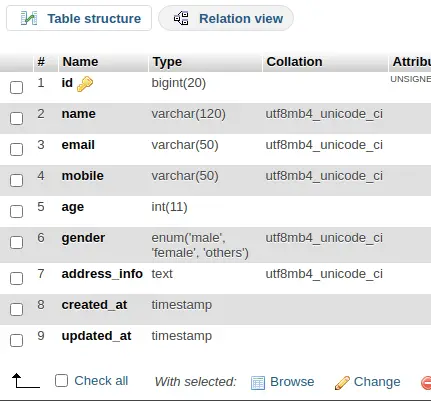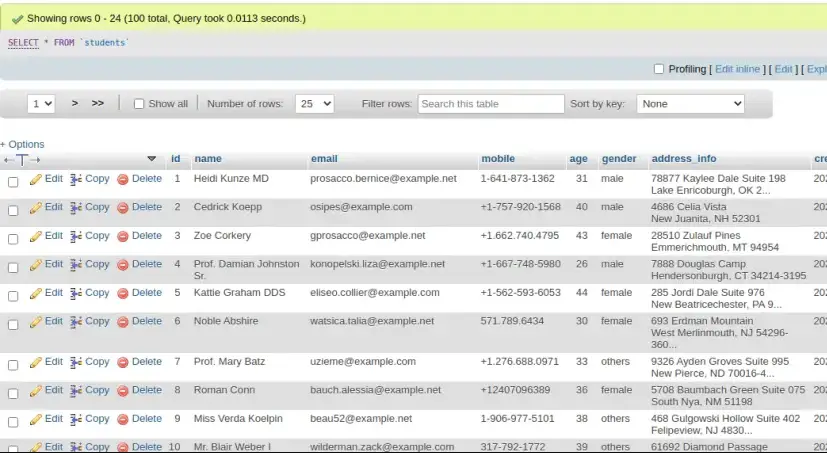Inside this article we will see the concept i.e Laravel 10 Concept of Route Model Binding with Example. Article contains the classified information i.e What is Route Model Binding & How to use it in Laravel 10 application.
Route Model Binding in Laravel is a technique that allows you to bind a model instance to a specific route, based on a route parameter. With route model binding, you can easily retrieve and work with models in your controllers without having to manually fetch them from the database.
Read More: How To Create Custom Facade in Laravel 10 Tutorial
Let’s get started.
Laravel Installation
Open terminal and run this command to create a laravel project.
composer create-project laravel/laravel myblogIt will create a project folder with name myblog inside your local system.
To start the development server of laravel –
php artisan serveURL: http://127.0.0.1:8000
Assuming laravel already installed inside your system.
Create Database & Connect
To create a database, either we can create via Manual tool of PhpMyadmin or by means of a mysql command.
CREATE DATABASE laravel_app;
To connect database with application, Open .env file from application root. Search for DB_ and update your details.
DB_CONNECTION=mysql DB_HOST=127.0.0.1 DB_PORT=3306 DB_DATABASE=laravel_app DB_USERNAME=root DB_PASSWORD=root
Read More: How To Use Trait in Laravel 10 Example Tutorial
Create Database Migration
We will create a students table using migration and then we seed test data inside it.
Open project into terminal and run this command to create migration file.
$ php artisan make:migration create_students_tableIt will create 2023_02_17_031027_create_students_table.php file inside /database/migrations folder. Open migration file and write this following code into it.
The code is all about for the schema of students table.
<?php
use Illuminate\Database\Migrations\Migration;
use Illuminate\Database\Schema\Blueprint;
use Illuminate\Support\Facades\Schema;
return new class extends Migration
{
/**
* Run the migrations.
*
* @return void
*/
public function up()
{
Schema::create('students', function (Blueprint $table) {
$table->id();
$table->string("name", 120);
$table->string("email", 50)->nullable();
$table->string("mobile", 50)->nullable();
$table->integer("age");
$table->enum("gender", ["male", "female", "others"]);
$table->text("address_info");
$table->timestamp("created_at")->useCurrent();
$table->timestamp("updated_at")->useCurrent();
});
}
/**
* Reverse the migrations.
*
* @return void
*/
public function down()
{
Schema::dropIfExists('students');
}
};
Run Migration
Back to terminal and run this command.
$ php artisan migrateIt will create students table inside database.

Create Application Model
Back to project terminal and run this command to create model.
$ php artisan make:model StudentIt will create Student.php file inside /app/Models folder. This file will help when we generate data using factory and insert into table.
Next,
Create Laravel Data Factory
Copy this command and run into terminal to create a factory file.
$ php artisan make:factory StudentFactoryIt will create a file StudentFactory.php inside /database/factories folder. Open file and write this following code into it.
<?php
namespace Database\Factories;
use Illuminate\Database\Eloquent\Factories\Factory;
/**
* @extends \Illuminate\Database\Eloquent\Factories\Factory<\App\Models\Student>
*/
class StudentFactory extends Factory
{
/**
* Define the model's default state.
*
* @return array<string, mixed>
*/
public function definition()
{
return [
"name" => $this->faker->name(),
"email" => $this->faker->safeEmail,
"mobile" => $this->faker->phoneNumber,
"age" => $this->faker->numberBetween(25, 45),
"gender" => $this->faker->randomElement([
"male",
"female",
"others"
]),
"address_info" => $this->faker->address
];
}
}
How To Call Model Factory
Open DatabaseSeeder.php from /database/seeders folder. Load model and factory.
<?php
namespace Database\Seeders;
use Illuminate\Database\Console\Seeds\WithoutModelEvents;
use Illuminate\Database\Seeder;
class DatabaseSeeder extends Seeder
{
/**
* Seed the application's database.
*
* @return void
*/
public function run()
{
\App\Models\Student::factory(100)->create();
}
}
Concept
\App\Models\Student::factory(100)->create();It will generate 100 fake rows of student using StudentFactory.php file and save into students table.
Read More: How To Work with Route Middleware in Laravel 10 Tutorial
Run Data Seeder
Back to project terminal and run this command to run factory to seed fake data.
$ php artisan db:seedIt will generate and save fake data into students table.

Setup Application Routes
Open web.php file from /routes folder. Add these routes into it.
//...
use App\Http\Controllers\StudentController;
// Route Model binding
Route::get("student/{student}", [StudentController::class, "index"]);
// Route Model binding
Route::get("student-by-email/{student:email}", [StudentController::class, "infoByEmail"]);
Create Controller
Open project into terminal and run this command into it.
$ php artisan make:controller StudentControllerIt will create StudentController.php file inside /app/Http/Controllers folder. Open controller file and write this code into it.
<?php
namespace App\Http\Controllers;
use Illuminate\Http\Request;
use App\Models\Student;
class StudentController extends Controller
{
public function index(Student $student) // Model
{
// Student data will be returned by student id getting from URL
return $student; // returns complete object
}
public function infoByEmail(Student $student) // Model
{
// Student data will be returned by student's email passing from URL
return $student; // returns complete object
}
}
Since the $student variable is type-hinted as the App\Models\Student Eloquent model and the variable name matches the {student} URI segment, Laravel will automatically inject the model instance that has an ID matching the corresponding value from the request URI.
If matching model instance is not found in the database, a 404 HTTP response will automatically be generated.
To get single value from object write $student->name etc.
Application Testing
Run this command into project terminal to start development server,
php artisan serveExample Routes:
- URL #1 – http://127.0.0.1:8000/student/2 [ Student by ID ]
- URL #2 – http://127.0.0.1:8000/student-by-email/sanjay@gmail.com [ Student by Email address ]
We hope this article helped you to learn about Laravel 10 Concept of Route Model Binding in a very detailed way.
Read More: How To Work with Group Middleware in Laravel 10 Tutorial
Online Web Tutor invites you to try Skillshike! Learn CakePHP, Laravel, CodeIgniter, Node Js, MySQL, Authentication, RESTful Web Services, etc into a depth level. Master the Coding Skills to Become an Expert in PHP Web Development. So, Search your favourite course and enroll now.
If you liked this article, then please subscribe to our YouTube Channel for PHP & it’s framework, WordPress, Node Js video tutorials. You can also find us on Twitter and Facebook.
